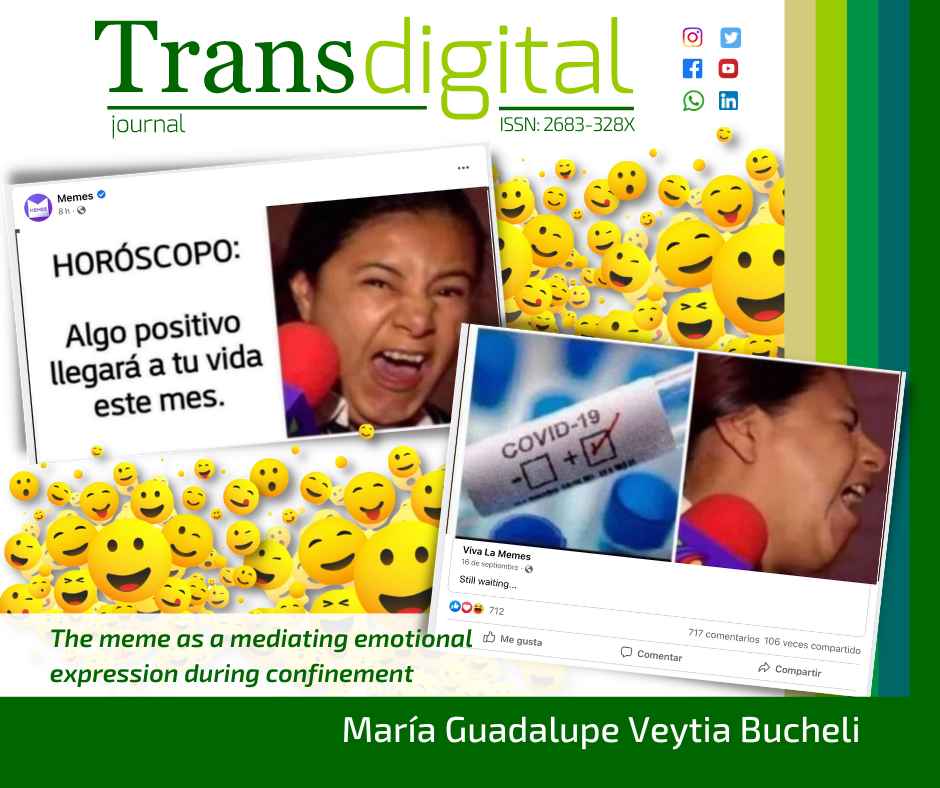The meme as a mediating emotional expression during confinement
DOI:
https://doi.org/10.56162/transdigital151Keywords:
Meme, emotions, culture, identity, adolescentsAbstract
The meme is a phenomenon of communication through social networks that has increased significantly in recent years, which expresses a point of view in the different areas of human life, for example in the context of politics, science, economics, health, education. In this sense, the objective of this research report is to present the results of the exploration of the emotional experience with the use of memes as mediators during the confinement of the COVID-19 pandemic. The study was carried out based on the memes shared by some third-year high school adolescents in the State of Hidalgo, México. We worked through a qualitative descriptive-interpretive methodology through content analysis since it allows us to review the structure, intertextuality, rhetoric of humor, themes and protagonism characterized in the memes sent. The collection and analysis of the information was carried out in the months of June and August 2021. From the analysis of 87 digital memes, it can be seen what the main characteristics of digital humor are, which contributed to the different states of mind. That adolescents went through during confinement. It is concluded that the emotion factor has an important load in memes and that the narrative and rhetoric of humor is a common form within the expression of the image for the projection of identity.
References
Alarcón Zayas, V. (2017). Humorismo como creación y fortalecimiento de los vínculos en la sociedad red: el caso de los memes sobre filósofos. Revista de Comunicación, 16(1), 122-146. https://revistadecomunicacion.com/article/view/1011/974
Altieri Megale, A. (2001). ¿Qué es la cultura?, La lámpara de Diógenes, 2(4), 15-20. https://www.redalyc.org/pdf/844/84420403.pdf
Álvarez Mendiola, G. (2020). Covid-19. Cambiar de paradigma educativo. Abran su cuaderno, blog del Consejo Mexicano de Investigación Educativa (COMIE). http://www.comie.org.mx/v5/sitio/2020/04/16/covid-19-cambiar-de-paradigma-educativo/
Arango Pinto, L. G. (2015). Una aproximación al fenómeno de los memes en Internet: claves para su comprensión y su posible integración pedagógica. Comun. Midia Consumo, 12(33), 109-131. https://revistacmc.espm.br/revistacmc/article/view/677/pdf_51
Bisquerra, R. (2009). Psicopedagogía de las emociones. Síntesis.
Bruner, J. (2006). Actos de significado. Más allá de la revolución cognitiva. Editorial Alianza.
Dawkins, R. (1990): El gen egoísta. Salvat Editores.
Del Pret, A. & Rendón Pantoja, S. (2020). Las redes sociales on-line: espacios de socialización e identificación de identidad. Psicoperspectivas, 19(1), 1-11. https://dx.doi.org/10.5027/psicoperspectivas-Vol19-Issue1-fulltext-1834
Flores, S. O., Jiménez, R. M., González N. Ma. G., Aragón, R. E., & Gazpar. C. J. (2016). Hábitos de los adolescentes sobre el uso de las Redes Sociales: caso de estudio en secundarias públicas. Revista Digital Universitaria. UNAM 17(10), 1-12. https://www.revista.unam.mx/vol.17/num10/art74/art74.pdf
González Carmona, F.L. (2017). Uso de memes como mediadores de las vivencias de estudiantes universitarios. XIV Congreso Nacional de Investigación Educativa. COMIE, 1-11, San Luis Potosí https://www.comie.org.mx/congreso/memoriaelectronica/v14/doc/0594.pdf
González H. E., Figueroa D. J., & Meyer, J.H. (2019). Los memes y la política. ¿Por qué algunos memes se vuelven virales y otros no? IC-Revista Científica de Información y Comunicación, 16, 579-613. https://icjournal-ojs.org/index.php/IC-Journal/article/view/468/383
IFT. (2019). Uso de las TIC y actividades por internet en México: Impacto de las características sociodemográficas de la población (versión 2019) 1-95. http://www.ift.org.mx/sites/default/files/contenidogeneral/estadisticas/usodeinternetenmexico.pdf
Knobel, M. & Lankshear, C. (2007) Online Memes, Affinities, and Cultural Production, en C. Lankshear, M. Knobel, C. Bigum & M. Peters (Eds.) A new literacies sampler, Peter Lang.
Lissack, M. R. (2004) The Redefinition of Memes: Ascribing Meaning to an Empty Cliché. Journal of Memetics - Evolutionary Models of Information Transmission, 5(8), 48-65. http://cfpm.org/jom-emit/2004/vol8/lissack_mr.html
Maeda González, C.M. (2015). Web 2.0 y fiestas populares: análisis de la creación de contenidos. Creatividad y Sociedad, 24, 161-186 http://creatividadysociedad.com/wp-admin/Art%C3%ADculos/24/7.%20Web%202.0%20y%20fiestas%20populares%20-%20%20analisis%20de%20la%20creacion%20de%20contenidos.pdf?_t=1576012012
Meso-Ayeredi, K., Mendiguren-Galdospín, T. & Pérez-Dasilva, J. (2017), Memes políticos difundidos por usuarios de Twitter. Análisis de la jornada electoral del 26J de 2016. El profesional de la información, 26(4), 672-683. http://eprints.rclis.org/39115/1/11.pdf
Muñoz Villar, C. (2014). El meme como evolución de los medios de expresión social. Seminario para optar al título de Ingeniero Comercial, Mención Administración. Santiago, Universidad de Chile. https://repositorio.uchile.cl/handle/2250/129749
Otzen, T. & Manterola, C. (2017). Técnicas de Muestreo sobre una Población a Estudio. Int. J. Morphol., 35(1), 227-232. http://www.intjmorphol.com/wp-content/uploads/2017/04/art_37_351.pdf
Pérez Salazar, G., Aguilar Edwars, A. & Guillermo Archilla, M.E. (2014). El meme en internet: Usos sociales, reinterpretación y significados, a partir de Harlem Shake. Argumentos. Estudios Críticos de la Sociedad, 27(75), 79-102. https://argumentos.xoc.uam.mx/index.php/argumentos/article/view/163/162
Plaza, J.Á. (2020). Digitalizados a marchas forzadas. Retina (El País), 27, 40-53. https://ep00.epimg.net/descargables/2020/04/23/9cc3241c37d475af4902c81d0b844025.pdf
Rodríguez-Ledo, C., Orejudo, H.S., Celma, P. L., y Cardoso, M. Ma. J. (2018). Mejora de las competencias socioemocionales en el aula, con jóvenes de Educación Secundaria, mediante el programa SEA. Electronic Journal of Research in Educational Psychology. ejrep. Universidad de Almería, 16(3), p681-701 http://hdl.handle.net/10835/6353
Ros-Martín, M. (2009). Evolución de los servicios de redes sociales en internet. Profesional de la información, 18(5), 552–557. https://doi.org/10.3145/epi.2009.sep.10
Rowan, J. (2015). VI. Memes. Inteligencia idiota, política rara y folclore digital. Capitán Swing.
Sola-Morales, S. (2020). Humor en tiempos de pandemia. Análisis de memes digitales sobre la COVID-19. Zer. 25(49), 33-58 https://doi.org/10.1387/zer.21817
Shifman, L. (2011). An anatomy of a YouTube meme. New Media & Society, 14(2), 187-203. https://doi.org/10.1177/1461444811412160
Ullmann, H. & Milosavljevic, V. (2016). El uso del tiempo en la adolescencia. Desafíos, boletín de la infacia y adolescencia, 19. https://repositorio.cepal.org/bitstream/handle/11362/40563/1/S1600862_es.pdf
UNICEF. (2020). Salud mental de las y los adolescentes ante el COVID-19. Recomendaciones para una nueva normalidad. UNICEF México. https://www.unicef.org/mexico/salud-mental-de-las-y-los-adolescentes-ante-el-covid-19
Wiggins, B. E., & Bowers, G. B. (2015). Memes as genre: A structurational analysis of the memescape. New Media & Society, 17(11), 1886–1906. https://doi.org/10.1177/1461444814535194

Downloads
Autor de correspondencia
El autor de correspodencia se identifica con el siguiente símbolo: *Published
How to Cite
License
Copyright (c) 2022 María Guadalupe Veytia Bucheli

This work is licensed under a Creative Commons Attribution 4.0 International License.
All articles in Transdigital are licensed under a Creative Commons Attribution 4.0 International License. Authors hold the copyright and retain publishing rights without restrictions.









